Children & Environmental Toxins: What Everyone Needs to Know
Air Date: Week of February 9, 2018
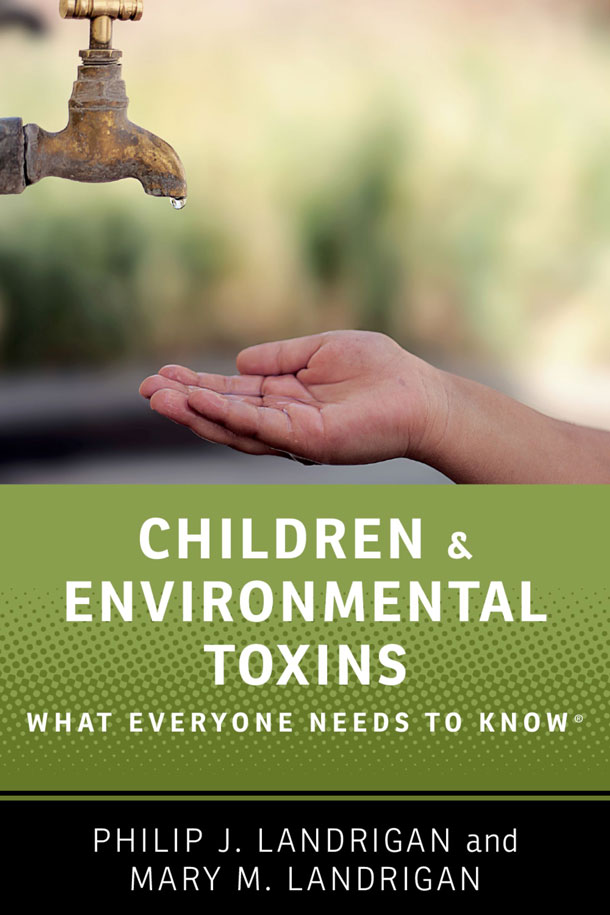
Children & Environmental Toxins: What Everyone Needs to Know is especially useful for parents who want to know how to protect their children from toxic chemicals. (Photo: courtesy of Oxford University Press)
Rates of childhood asthma, learning problems, and cancer have been on the rise for decades -- and toxic chemicals, most of which are never tested for safety before they're sold, appear to be major culprits. In this conversation with host Steve Curwood, pediatrician Philip J. Landrigan connects the dots between exposure to environmental toxins and disease and shares strategies parents and child advocates can use to keep kids safe in a world full of pollution and awash in thousands of chemicals. Philip and his wife Mary Landrigan are co-authors of the new book, Children & Environmental Toxins: What Everyone Needs to Know.
Transcript
CURWOOD: It’s Living on Earth, I’m Steve Curwood. In their new book Children & Environmental Toxins: What Everyone Needs to Know, Philip and Mary Landrigan bring together research on the risks chemicals pose to children in the form of a guide for parents, policymakers and the public. Philip Landrigan MD is Dean of Global Health and runs the Children Environmental Health Program at the Icahn Medical School at Mt Sinai Hospital in New York City. He joins me now. Dr. Landrigan, welcome back to Living on Earth!
LANDRIGAN: Steve it's great to be back with you.
CURWOOD: So what has changed about childhood health issues today from generations ago?
LANDRIGAN: Well I think the big change today from twenty five or fifty years ago is the extraordinary number of new manmade chemicals that have come into children's environment. These are chemicals that go into toys and cosmetics and soaps and household products and they're chemicals to which children are exposed to every single day.
CURWOOD: Now why do these chemicals pose such a risk to children's health?
LANDRIGAN: Well the fundamental problem is that the government in this country is not doing a good job of protecting children against toxic chemicals, and what I mean by that is that there is no enforced requirement in the United States that new chemicals be tested for safety or evaluated for toxicity before the chemicals come to market. The chemicals are simply given a free pass, they're allowed to come into the market, they go into products, they get out into the environment. And then, sadly, time and time again we have found out the hard way that these chemicals damage children's health. We really must do a better job in this country of assuring chemical safety and protecting children's health.
CURWOOD: Talk to me about the health effects associated with these chemicals.
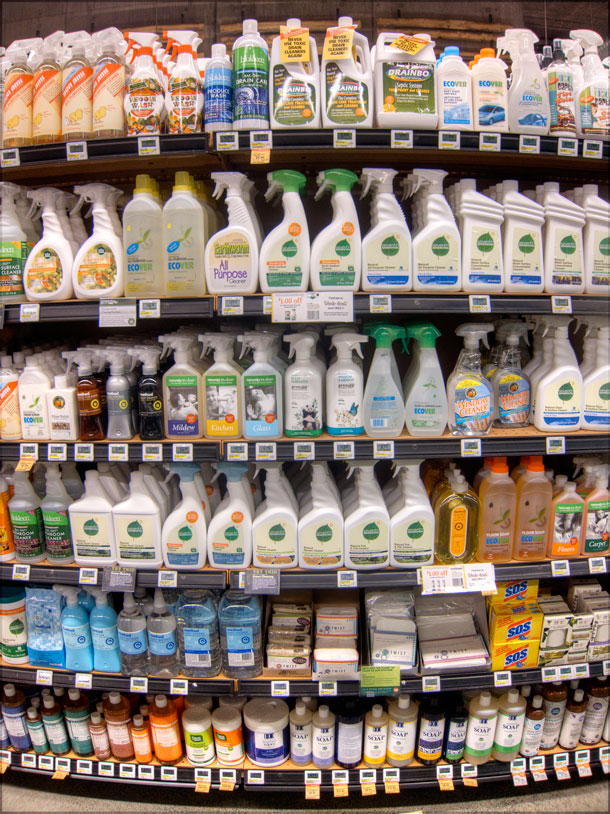
Dr. Phil Landrigan says avoiding certain particularly toxic cleaning products – oven cleaners and drain cleaners are especially harmful to health – can help reduce children’s exposure to these chemicals. (Photo: kleer001, Flickr CC BY-NC 2.0)
LANDRIGAN: Well of course different chemicals have different health effects. Lead was one of the first toxic chemicals whose effects on children we discovered. And we now know that lead damages children's brains; causes loss of I.Q., shortening of attention span; disruption of behavior. And we've come to learn that those effects happen even at the very lowest levels of lead exposure to children; even a tiny dose of lead can be dangerous to a child's brain. Another class of chemicals are known as endocrine disruptors. These are chemicals that get into a child's body, interfere with the hormonal normal chemical signaling that takes place in the child's body and these disrupters can have very negative effects on a child's development. One class of endocrine disruptors are the phthalates. Phthalates are man made chemicals that are put into rigid plastics to make them flexible. They're known as plasticizers in the trade. Unfortunately the phthalates don't stay in plastics such as P.V.C. They escape; they get into food, and if phthalates get into a baby, especially if they get in by way of the mother, during pregnancy when the baby is still in the womb, these chemicals can mess up the development of the male reproductive organs in a baby boy and increases the risk of reproductive malformations. Phthalates can also damage brain development like lead, cause reduced I.Q. And then a third class of chemicals that have become very common in the modern environment are known as brominated flame retardants. Flame retardants are in couches, in carpets, in computers. The problem is they escape from those products; they get in the house dust and when a young child or a pregnant mom is exposed to them they too can get into the baby and cause brain damage to the baby with reduction in intelligence.
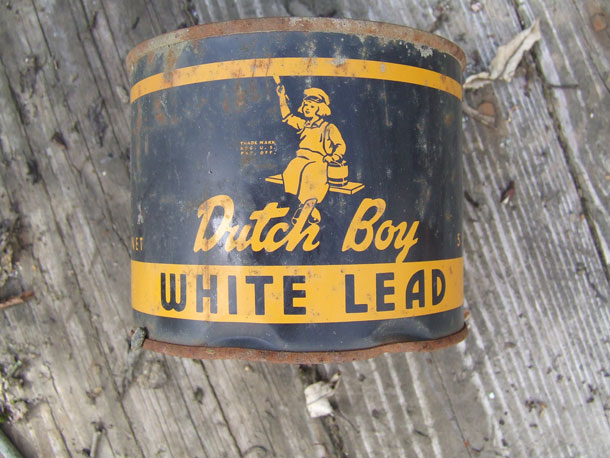
Lead paint still exists in millions of U.S. homes, especially those built before the 1970s. (Photo: Thester11, Wikimedia Commons CC BY-SA 3.0)
CURWOOD: A number of years ago I attended a symposium you gave on the risks of some of these chemicals, and the relationship to learning disabilities; I believe there was a county someplace in North Carolina where you found a rather high incidence. What's the link between learning disabilities and some of these chemicals?
LANDRIGAN: Well, over the past fifteen or twenty years we have learned that a number of manmade chemicals can cause learning disabilities in children. These include lead; mercury; polychlorinated biphenyls, known as P.C.B.s; brominated flame retardants that go into carpets and couches; and a number of pesticides; and lastly a number of the endocrine disruptors such as phthalates and bisphenol A. And what happens is that if these chemicals get into a young child or if they get into a woman while she's pregnant, they get through into the mother's baby, they can cause injury to the brain of the child. And then that injury shows up when the child is two, three, four or five years old as slowed learning, diminished I.Q., short attention span, disrupted behavior; sometimes even attention deficit hyperactivity disorder, A.D.H.D.; and sometimes autism.
CURWOOD: And how common is this now?
LANDRIGAN: Learning disabilities are now calculated to affect one out of every six children born in the United States-- about fifteen percent of all American children. That data comes from the C.D.C. In Atlanta.
CURWOOD: What relationship do these chemicals have to the childhood obesity epidemic we're seeing?
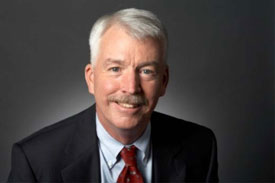
Dr. Phil Landrigan is the Founding Director of the Children’s Environmental Health Center at the Icahn School of Medicine at Mt. Sinai Hospital in New York City. (Photo: courtesy of Phil Landrigan)
LANDRIGAN: Well obesity is a complex story. And it's driven by multiple factors; new foods that are rich in fat and salt are a big problem; lack of exercise is a big problem; but chemicals also make a contribution. And there are some chemicals, actually some of the endocrine disruptors that can alter glucose and fat metabolism in the human body and tilt the scales in the direction of obesity. So if you have a child who's already not getting the right food and already not getting enough exercise and then that child is already exposed to some of these chemicals-- can tilt the balance.
CURWOOD: Childhood cancers seem to be on the rise; what are some of the theories on how might these be linked to chemicals?
LANDRIGAN: Childhood cancer is a good news/bad news story. The good news is that thanks to the heroic pediatricians at places like Boston Children's and St Jude's and other children's hospitals around the country, we save something like seventy five or eighty percent of kids with leukemia, and a very high proportion of kids with brain cancers-- leukemia and brain cancers are the two most common childhood cancers. But the bad news is that the incidence, which is to say the number of new cases per thousand children, has been rising steadily for the past forty years and more. We've seen a more than forty percent cumulative increase in incidence of cancer over this time. We know some of the chemicals that are driving this increase. We know that benzene can cause leukemia. There's a chemical called 1,3-Butadiene which goes into synthetic rubber and shows up in truck tires; there are various solvents that are in drinking water. But I don't think anybody can claim to know totally why rates of childhood cancer are going up; it still remains to be determined.
CURWOOD: Dr. Landrigan, you write that these health impacts can appear in childhood as well as much later in life. Why do some of these impacts take so long to manifest?
LANDRIGAN: Well the understanding has grown in the last fifteen or twenty years that negative exposures that occur to an infant in the womb or to a child in the first couple of years after birth can have negative effects all across the human lifespan. The very first studies that helped illuminate that question are actually studies of babies who were malnourished during pregnancy. And scientists in Great Britain who were studying children who have been malnourished during World War II in Holland found that when these children became fifty and sixty years old they had very greatly increased incidence of hypertension, heart disease, stroke, diabetes. Since that time we've come to understand that what's called fetal programming-- the changes in the expression of the genes in the infant in the womb, fetal programming-- can be caused not only by nutrition but also by toxic chemicals. And scientists are are beginning to explore this question now, map out how it happens. But I think it's becoming increasingly clear that toxic chemical exposures in early life are going to increase risk for a whole range of diseases when kids grow up-- everything from heart disease to cancer to kidney disease.

Phil’s wife and coauthor Mary Landrigan is a health educator who spent 25 years at the Westchester County Department of Health in New York. (Photo: courtesy of Phil Landrigan)
CURWOOD: Explain for me the concept that toxic chemicals can cause health problems without any symptoms, I guess what you folks call subclinical toxicity?
LANDRIGAN: Yes. It was during studies of lead, children exposed to lead that we first came to realize back in the 1970s that even very low levels of exposure to a toxic chemical, levels that are too low to produce any obvious symptoms in a child, could still cause damage to the child. And so when we started doing that work back in the seventies, the theory on lead poisoning was that it either made a child very very sick-- coma, convulsions, even death-- or the child recovered and that was the end of the story. But that seemed a little artificial to some of us, and so we started to look at children with lower levels of lead. Lo and behold we found that these children had loss of I.Q., behavioral problems; and that opened up the whole realization that low dose exposures to toxic chemicals could cause damage in children. And that's now become a very general recognition, almost any chemical you can think about has a range of exposures. Obviously the worst exposures create the most severe disease, but even low dose exposures can cause real damage.
CURWOOD: Now, Dr. Landrigan, we're talking to you about the book that you've written with your wife, Mary Landrigan, which is about children and environmental toxins-- and the subtitle is What Everyone Needs to Know. So it's a handbook, there are a lot of suggestions and comments and such here; we don't have time of course to go over all of them here. But let me ask you some basic questions. Let's start with, how can people protect themselves at home from dangerous chemicals?
LANDRIGAN: I think the very first thing that people have to do to protect their children against toxic chemicals is they have to take a little time to educate themselves, just as you educate yourself before you buy a new car, you buy a new house and you learn the basic operating systems-- you have to read just a little bit about lead, about pesticides, about air pollution, about the other toxic chemicals that can affect your child. And then when a parent is armed with that knowledge they are empowered to protect their children against toxic chemicals. So how can a mom or dad protect their child against toxic chemicals in the home. Start with the big ones: lead paint in older homes, built before 1977, is still a big problem in America. There are still millions of homes that have lead paint, and so a parent needs to follow the directions we give in the book to understand if there's lead paint, and if they find lead paint in a place accessible to a child they have to bring in somebody who knows what they're doing to remove or at least cover up that lead paint.

Severe air pollution in Anyang, China. (Photo: V.T. Polywoda, Flickr CC BY-NC-ND 2.0)
The worst thing a parent can do is to try to remove it themselves because that creates a very toxic dust, a lead contaminated dust which can cause severe poisoning. Another thing that parents can do in their home is minimize the amount of pesticides that come into the home. One thing they can do is buy organic. Now I know full well that organic produce costs more than regular produce, but the gap is narrowing; organic is getting cheaper than it used to be. If you shop wisely you can get organic for very little more than conventional. And the gain that results from eating organic is that families who do so have ninety percent less pesticides in their body. And then one last thing that parents can do in their homes is not immediately reach for the can of insecticide or the canister of insecticide that they put on the front lawn. You can control cockroaches and other vermin in the home if you do what's called Integrated past management, which is an approach that minimizes chemicals and relies on cleaning up food and other debris that cockroaches feed on. And when it comes to your front lawn, I always say to people, learn to live with a few dandelions. They're quite beautiful and in fact in the springtime you can make a salad out of them.
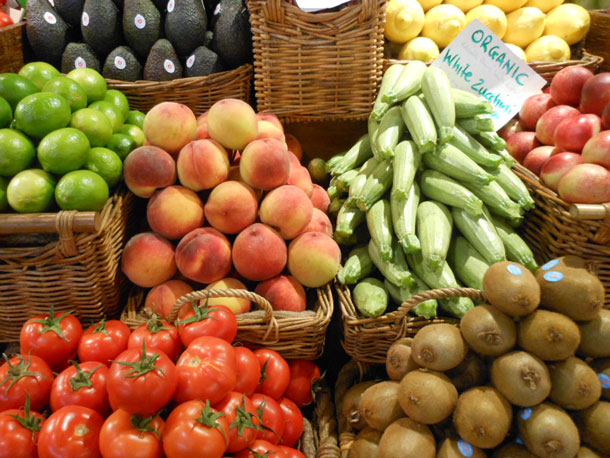
Eating organic produce can reduce the amount of pesticides a person ingests by 90 percent. (Photo: Michael Coghlan, Flickr CC BY-SA 2.0)
CURWOOD: Or tea, for that matter.
LANDRIGAN: Or tea, yes.
CURWOOD: In your book you talk a bit about steps to take to protect reproductive health. What are those?
LANDRIGAN: It's very important that couples who are thinking about having a baby take steps-- ideally before they become pregnant-- but in any case during the pregnancy, take steps to protect the baby in the mother's womb against toxic chemicals. So I think it's become common knowledge that mom shouldn't drink alcohol or take recreational drugs or smoke tobacco during pregnancy. Now we're advising parents to take that kind of advice, go a step further. Be very careful you don't sand down any lead paint when you're pregnant, because it will get into your body and damage your child. Eat fish-- fish are very very important for the baby's brain growth-- but eat the right fish. There are charts available, for example, from N.R.D.C., the Natural Resources Defense Council; from the Monterey Bay Aquarium and other groups which specify which are the safe kinds of fish and which are the dangerous kinds of fish. The dangerous fish have high levels of mercury, high levels of P.C.B. Pregnant mums want to avoid those. And finally avoid pesticides when you're pregnant. Any pesticide that you spray in your house on your lawn in your garden when you're pregnant is going to get into your baby, and that's not good.
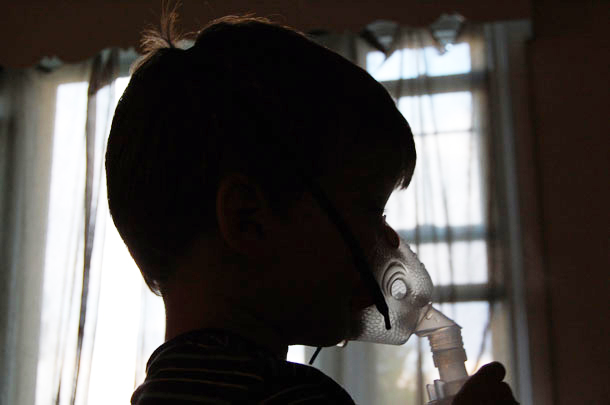
Asthma is exacerbated by air pollution, smoking, and chemicals that irritate the airways. (Photo: KristyFaith, Flickr CC BY-NC-ND 2.0)
CURWOOD: There seems to be an awful lot of allergy and asthma attacks among children these days. How can parents help their kids avoid those?
LANDRIGAN: Asthma has become a big problem in American children. Rates of asthma have more than tripled in American kids since the 1970s. One of the big drivers of asthma is air pollution. Children who live near highways, children who live in polluted inner city neighborhoods have substantially more asthma than kids who live in clean areas. So there are several things that parents can do. On really bad days when the air pollution outside is bad, keep the house buttoned up. Never never smoke in the home or in the hallway outside the apartment because that smoke is a powerful source of toxic chemicals that can trigger asthma in a child. If you have the freedom to choose to live in a place where the air is better, do so, although I realize in a lot of cases that's simply not possible for economic reasons, job reasons; but still it's advice we always put out there and sometimes people can act upon it.
CURWOOD: Tell me how our governments are doing in protecting children from toxins. Briefly, what are the good points and what needs improvement in your view?
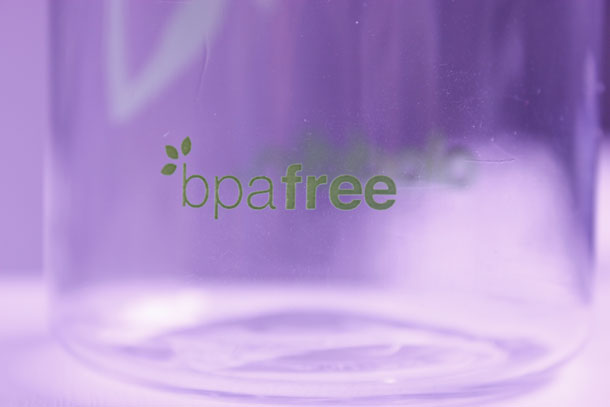
In recent years there has been significant consumer pressure for companies to remove BPA (Bisphenol A), an endocrine disruptor, from plastics like water bottles. (Photo: Hteink.min, Wikimedia Commons CC BY-SA 3.0)
LANDRIGAN: Well over the last fifty years the US federal government has done many many very good things to protect children against toxic chemicals in the environment. One of the biggest actions they ever took was started in 1975, when they removed lead from gasoline, when EPA removed lead from gasoline. That has resulted in a more than ninety percent drop in children's blood lead levels in the United States and an average increase in children's I.Q. Across the country of more than five points. It's the reason our kids are smarter than we are because they're no longer exposed to lead from gasoline. Another really good thing that the federal government has done is clean up air pollution. Since we passed the Clean Air Act in this country in 1970, the six major air pollutants have declined by more than seventy percent. And it's interesting that during that same time that air pollution has declined by seventy percent, the gross domestic product in this country has increased by two hundred fifty percent. So anybody who tells you that cleaning up pollution is going to kill the economy doesn't know what they're talking about. So that's the good news side of the story. The bad news is that right now the federal government is moving in the wrong direction. And they're actively unraveling protections that are designed to safeguard human health. So for example the plan to scrap the Clean Air Act and to allow coal fired power plants to put more pollution into the air is going to result in more cases of asthma, more cases of pneumonia, more cases of premature birth, more stillbirths in American children. The plan to allow certain very toxic pesticides like chlorpyrifos to remain on the market -- chlorpyrifos is a chemical that causes brain damage to unborn children in the womb -- the current U.S. E.P.A. Administrator is allowing this chemical to remain on the market even though scientists within his own agency have urged him to take it off the market to protect kids against brain damage. Actions like that are not good for our kids. So I think the upshot of all that is parents who care about these issues have to act within their homes and act within their communities to protect their children. But they also have to consider getting involved more broadly -- joining the P.T.A., running for office, making their voices heard in the public space, and most of all voting. Ultimately if you want to protect your children, you got to vote and you've got to put people into office who will take action to protect your children. You can't shop your way out of it. Smart shopping helps but you can't shop your way out of dirty air, you need government to help you there.
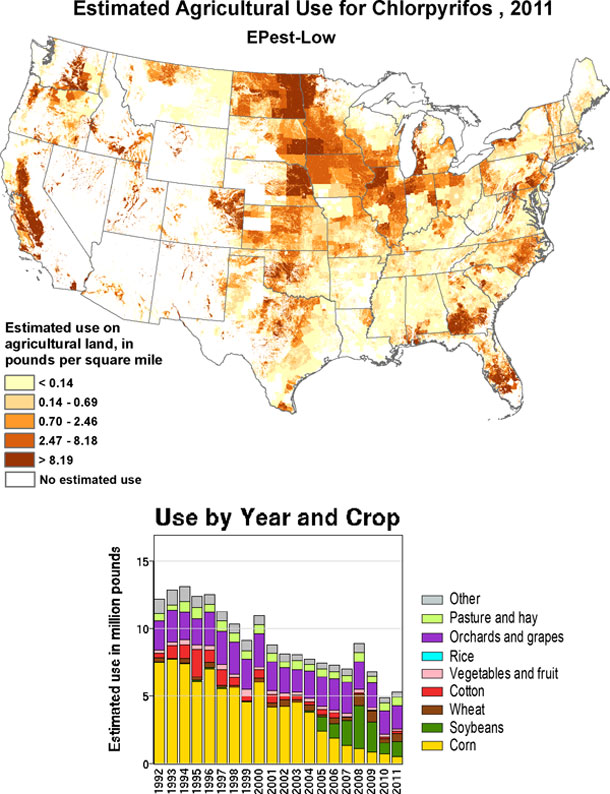
Graph showing estimated use of the pesticide Chlorpyrifos, a neurotoxin that the EPA declined to ban last year, in the U.S. (Photo: United States Geological Survey, via Wikimedia Commons [Public Domain])
CURWOOD: So what improvements have you seen in getting some of these chemicals off the market, particularly in consumer products?
LANDRIGAN: Well in recent years, despite the recalcitrance of the federal government, we have seen positive actions in protecting children against toxic chemicals. First of all, some of the states have been very proactive -- California for example is in the process of banning various toxic chemicals. And because the market in California is so great, any action that takes place in California has ripple effects that goes across the country. We've also seen market pressure, consumer pressure, make a difference. So for example many many parents in the last two years have refused to buy baby bottles that contain phthalates, and parents have refused to buy water bottles that were made of bisphenol A. And in consequence of those actions markets have moved; manufacturers have taken phthalates, they've taken B.P.A. out of a number of consumer products.
CURWOOD: Philip Landrigan is a pediatrician and founding director of the Children's Environmental Health Program at Mt Sinai's Icahn School of Medicine. And he's co-author of Children and Environmental Toxins: What Everyone Needs to Know. Dr. Landrigan, thanks so much for taking the time with us today.
LANDRIGAN: Steve, it's been a pleasure, thank you.
Links
Children & Environmental Toxins: What Everyone Needs to Know
Living on Earth wants to hear from you!
Living on Earth
62 Calef Highway, Suite 212
Lee, NH 03861
Telephone: 617-287-4121
E-mail: comments@loe.org
Newsletter [Click here]
Donate to Living on Earth!
Living on Earth is an independent media program and relies entirely on contributions from listeners and institutions supporting public service. Please donate now to preserve an independent environmental voice.
NewsletterLiving on Earth offers a weekly delivery of the show's rundown to your mailbox. Sign up for our newsletter today!
 Sailors For The Sea: Be the change you want to sea.
Sailors For The Sea: Be the change you want to sea.
 The Grantham Foundation for the Protection of the Environment: Committed to protecting and improving the health of the global environment.
The Grantham Foundation for the Protection of the Environment: Committed to protecting and improving the health of the global environment.
 Contribute to Living on Earth and receive, as our gift to you, an archival print of one of Mark Seth Lender's extraordinary wildlife photographs. Follow the link to see Mark's current collection of photographs.
Contribute to Living on Earth and receive, as our gift to you, an archival print of one of Mark Seth Lender's extraordinary wildlife photographs. Follow the link to see Mark's current collection of photographs.
 Buy a signed copy of Mark Seth Lender's book Smeagull the Seagull & support Living on Earth
Buy a signed copy of Mark Seth Lender's book Smeagull the Seagull & support Living on Earth

